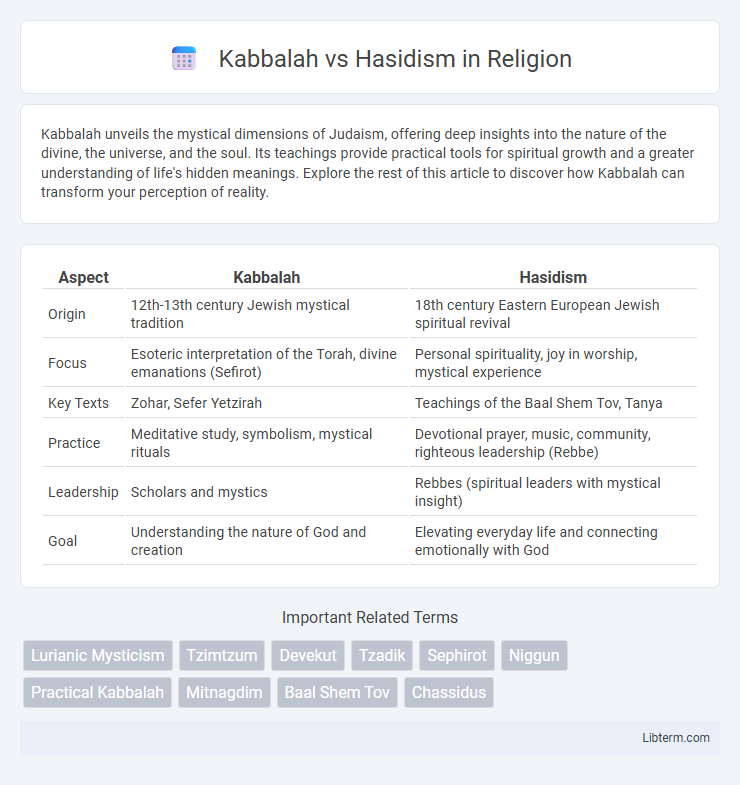Kabbalah unveils the mystical dimensions of Judaism, offering deep insights into the nature of the divine, the universe, and the soul. Its teachings provide practical tools for spiritual growth and a greater understanding of life's hidden meanings. Explore the rest of this article to discover how Kabbalah can transform your perception of reality.
Table of Comparison
| Aspect | Kabbalah | Hasidism |
|---|---|---|
| Origin | 12th-13th century Jewish mystical tradition | 18th century Eastern European Jewish spiritual revival |
| Focus | Esoteric interpretation of the Torah, divine emanations (Sefirot) | Personal spirituality, joy in worship, mystical experience |
| Key Texts | Zohar, Sefer Yetzirah | Teachings of the Baal Shem Tov, Tanya |
| Practice | Meditative study, symbolism, mystical rituals | Devotional prayer, music, community, righteous leadership (Rebbe) |
| Leadership | Scholars and mystics | Rebbes (spiritual leaders with mystical insight) |
| Goal | Understanding the nature of God and creation | Elevating everyday life and connecting emotionally with God |
Historical Origins of Kabbalah and Hasidism
Kabbalah, rooted in 12th-century Provence and flourishing through the 13th-century Zohar in Spain, represents the foundational mystical tradition of Judaism exploring divine emanations and mystical interpretations of the Torah. Hasidism emerged in 18th-century Eastern Europe, founded by Rabbi Israel Baal Shem Tov, as a spiritual revival movement emphasizing joyous worship and accessible mysticism within the Kabbalistic framework. While Kabbalah provided the esoteric universe of divine mysteries, Hasidism democratized these concepts, embedding them into popular Jewish religious life and culture.
Core Philosophical Differences
Kabbalah centers on the mystical exploration of the divine emanations (Sefirot) and cosmic unity, emphasizing esoteric knowledge and metaphysical concepts rooted in the Zohar. Hasidism, emerging from Kabbalistic teachings, prioritizes personal piety, joyous worship, and the spiritual connection between the individual and God through a Rebbe, focusing on immanence rather than abstract mysticism. The core philosophical difference lies in Kabbalah's abstract contemplation of divine realms versus Hasidism's practical, devotional application of those mystical ideas to everyday life.
Key Texts and Teachings
Kabbalah primarily revolves around core texts such as the Zohar and Sefer Yetzirah, emphasizing mystical interpretations of the Torah and the nature of the divine through the sefirot. Hasidism, rooted in Kabbalistic thought, centers on the teachings of the Baal Shem Tov, highlighting the immanence of God, joy in worship, and the importance of the tzaddik or spiritual leader. While Kabbalah offers complex metaphysical frameworks, Hasidism translates these mystical principles into accessible, devotional practices for daily life.
Spiritual Practices and Rituals
Kabbalah emphasizes intricate mystical meditation, Hebrew letter permutations, and contemplation of the sefirot to achieve divine connection, often performed by advanced mystics. Hasidism, rooted in Kabbalistic principles, incorporates joyful prayer, spontaneous song, and storytelling to foster personal spirituality and communal worship, emphasizing devekut, or cleaving to God in everyday life. Both traditions utilize ritual objects like the menorah and tefillin but differ in practice intensity and accessibility, with Hasidism promoting broader spiritual engagement among followers.
Mystical Approaches to God
Kabbalah presents a foundational mystical framework emphasizing the emanations of the Divine through the Sefirot, revealing a complex, symbolic map of God's interaction with the universe. Hasidism, emerging from Kabbalistic roots, incorporates ecstatic worship, emphasizing personal, heartfelt connection and divine immanence in everyday life. Both traditions prioritize spiritual elevation but differ in practice: Kabbalah is more esoteric and intellectual, while Hasidism focuses on joyful devotion and communal experience.
Leadership Structures and Influential Figures
Kabbalah centers around mystical teachings often disseminated by individual sages such as Rabbi Isaac Luria, whose esoteric insights shaped its core doctrines. Hasidism, a spiritual movement embracing Kabbalistic concepts, developed a more organized leadership structure led by dynastic rebbes like the Baal Shem Tov, who emphasized charismatic authority and communal guidance. While Kabbalah remains primarily a scholarly and mystical tradition, Hasidism institutionalizes its teachings through hierarchical leadership and influential figures who cultivate close relationships with their followers.
Community and Social Organization
Kabbalah centers on mystical teachings that individuals study primarily through texts and personal spiritual practice, often within scholarly or elite circles. Hasidism emerges as a social movement emphasizing communal worship, joyous prayer, and the leadership of a Rebbe who guides followers in both spiritual and daily life. Hasidic communities organize tightly-knit social structures fostering collective identity, mutual support, and adherence to shared religious customs, contrasting with the more individualistic and esoteric study of Kabbalah.
Role of Music, Prayer, and Meditation
Kabbalah emphasizes meditation and mystical contemplation as primary tools for spiritual elevation, while Hasidism integrates joyous music and heartfelt prayer to foster direct emotional connection with the Divine. Hasidic melodies (nigunim) serve to elevate the soul and create communal spiritual energy during prayer, contrasting with Kabbalah's more individual, meditative focus. Both traditions value prayer deeply, but Hasidism transforms it into an accessible, ecstatic experience using music, dance, and emotional expression.
Modern Interpretations and Adaptations
Modern interpretations of Kabbalah emphasize its mystical teachings through accessible language and psychological insights, appealing to a broad, often secular audience. Hasidism adapts these mystical elements into vibrant communal practices and ecstatic worship, maintaining a strong emphasis on spirituality within everyday life. Contemporary movements often blend Kabbalistic concepts with Hasidic joy, creating dynamic, modern spiritual expressions that resonate globally.
Impact on Jewish Thought and Culture
Kabbalah profoundly shaped Jewish mysticism by introducing complex metaphysical concepts such as the Ein Sof and the Sefirot, which influenced theological interpretations and spiritual practices throughout Jewish history. Hasidism transformed Jewish culture by popularizing Kabbalistic ideas, making mystical experiences accessible to the broader Jewish populace through emphasis on joy, prayer, and the role of the tzaddik (righteous leader). Both movements significantly impacted Jewish thought, with Kabbalah providing a foundational mystical framework and Hasidism fostering communal identity and religious revival across Eastern European Jewry.
Kabbalah Infographic

 libterm.com
libterm.com